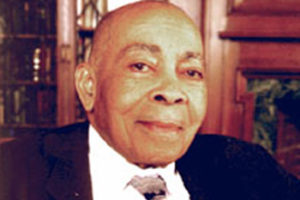
Warren E. Henry
Warren Henry’s birth in 1909 is marked on this date. He was a Black scientist.
Warren Elliot Henry was born in Evergreen, Alabama, on a peanut farm where George Washington Carver lived and did research during the summer months. Both his parents were graduates of Tuskegee Institute, and young Warren was reading when he was four, occasionally going on walks with his father and Carver. He, too, attended Tuskegee Institute, where he majored in three subjects: mathematics, English, and French, earning a Bachelor of Science.
He served as principal at a segregated school in rural Ardmore, AL. While there, he received a summer scholarship to Atlanta University, where, in graduate school, he taught classes at Spelman and Morehouse Colleges.
1937: Henry earned a Master of Science in Organic Chemistry from Atlanta University. 1941: He earned a Ph.D. in Physical Chemistry from the University of Chicago. He wanted to continue with research, and a Ph.D. should have guaranteed him a research position. But in those days, only the historically Black schools offered him a job teaching. Thus, he returned to Tuskegee Institute, where some of his students were members of the 99th Pursuit Squadron, the Tuskegee Airmen.
From there, Henry secured a position at the Massachusetts Institute of Technology (MIT)'s Top-secret Radiation Laboratory. From 1943-1946, he developed video amplifiers used in portable radar systems on warships. He then became chair of the Department of Physics at Morehouse College. The summer after his year at Morehouse, Henry moved on to the Office of Naval Research, where he stayed for 12 years, from 1948 to 1960.
During the 1950s, his research and knowledge of materials at extremely low temperatures were probably unsurpassed in America. While at the Naval Research Laboratory, Henry headed the group that installed the high-field Bitter Magnet. Henry also worked at the University of California-Berkeley as a guest investigator at the Giauque Lab under the auspices of Glenn Seaborg.
In the 1960s, while at Lockheed Space and Missile Co., he developed guidance systems for detecting submarines and helped design the hovercraft specially developed for night fighting during the Vietnam War. Henry's nearly seven decades of work in magnetism and superconductivity have earned him praise as one of the most eminent African American scientists in American history.
He wrote or contributed to hundreds of scientific articles and co-authored the 1934 book “Procedures in Elementary Qualitative Chemical Analysis.” His monograph on Para magnetism (Halliday and Resnick Electricity and Magnetism) has been a physics textbook standard for years in the U.S. Many textbooks include his demonstration of the proof of non-interacting paramagnetic ions. Students are often first introduced to Henry's work in solid-state physics or material science courses, where his research is quoted extensively.
Henry was a Fellow of the American Physical Society and the American Association for the Advancement of Science. He was also the recipient of many awards, including The Tuskegee Alumni Award, Carver Award, Outstanding Educator in America, Lifetime Achievement Award in the Community from the National Science Foundation, and the 1997 Technical Achiever of the Year Award from the National Technical Association.
In March 1997, he received the 1st Annual Golden Torch Award for Lifetime Achievement in Engineering, which the National Society of Black Engineers sponsored. He was also awarded the National Science Foundation's Lifetime Achievement Award in Community Service. He was nominated for the National Medal of Science, the highest U.S. science honor given by the nation's president. In 1997, Howard University and the Ernest Orlando Lawrence Berkeley National Laboratory in California honored him.
After he retired, Henry continued for another twenty years with a program for Blacks called Minorities Access to Research Careers (MARC), which encourages third—and fourth-year college students to join scientific teams. Warren Elliot Henry died on October 31, 2001.
Created Equal The Lives and Ideas of Black American Innovators
By James Michael Brodie
Copyright 1993, by Bill Adler Books, Inc.
William Morrow and Co. Inc., New York
ISBN 0-688-11536-5